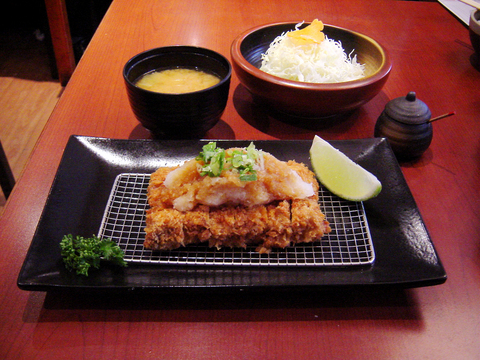If you think most Taipei urbanites are stuck in the rat race and would be too busy to stand in line for over 30 minutes to secure a pork chop for lunch, check out the tonkatsu eatery hidden behind the Cathay General Hospital on Renai Road. A beneficiary of the influence wielded by bloggers and online chat room gossipers, the restaurant's sets, consisting of a breaded, deep-fried pork cutlet served Japanese-style, are hot property.
Is the wait worthwhile?
Dinners can choose to fill up on the popular Japanese meal in two ways: traditional or innovative.

PHOTO: HO YI, TAIPEI TIMES
One option is pork chop served with daikon, or white radish, mash.
If simplicity is not your style, the restaurant does a range of pork cutlets stuffed with various fillings. For NT$310, patrons can make their own combinations of pork chop with two choices from over 10 options including cheese, kimchi, tuna salad, egg, crab meat and curry sauce.
Cheese tonkatsu seems to be the restaurant's tour de force. In one bite, the gooey cheese coats the chop's crispy layer and succelent meat creating a sumptuous trio of textures. The cheese and curry chop, on the other hand, tries too hard, and packs too much of a punch with a confusing array of flavors.
The kimchi option is sour, sweet, spicy and piquant, without one flavor dominating the dish. For those who want a feast for the eyes as well as one for the stomach, the laver and steamed eggs set and the plum sauce and crab option are must-tries.
Adding condiments to the meal is a treat in itself as diners are provided with pestles in which to grind white sesame seeds and other spices.
Fresh shredded cabbage, miso soup and high-quality rice come in unlimited supply with the sets.
As the establishment is pretty much full day and night, weekdays and weekends, the motto of the wait staff is to serve up the fare as quickly as possible with passable courtesy. Dishes are served at an admirable speed while wait staff politely ask permission to clean up empty plates from time to time. It is not an ideal venue for a lengthy tete-a-tete with an old lover. Don't hesitate to prevent the eager wait staff from taking away your half-finished food and be careful with the mustard dressing, it is fiery stuff and could have you wincing and blubbering through your entire meal.

Most heroes are remembered for the battles they fought. Taiwan’s Black Bat Squadron is remembered for flying into Chinese airspace 838 times between 1953 and 1967, and for the 148 men whose sacrifice bought the intelligence that kept Taiwan secure. Two-thirds of the squadron died carrying out missions most people wouldn’t learn about for another 40 years. The squadron lost 15 aircraft and 148 crew members over those 14 years, making it the deadliest unit in Taiwan’s military history by casualty rate. They flew at night, often at low altitudes, straight into some of the most heavily defended airspace in Asia.

Beijing’s ironic, abusive tantrums aimed at Japan since Japanese Prime Minister Sanae Takaichi publicly stated that a Taiwan contingency would be an existential crisis for Japan, have revealed for all the world to see that the People’s Republic of China (PRC) lusts after Okinawa. We all owe Takaichi a debt of thanks for getting the PRC to make that public. The PRC and its netizens, taking their cue from the Chinese Communist Party (CCP), are presenting Okinawa by mirroring the claims about Taiwan. Official PRC propaganda organs began to wax lyrical about Okinawa’s “unsettled status” beginning last month. A Global

Taiwan’s democracy is at risk. Be very alarmed. This is not a drill. The current constitutional crisis progressed slowly, then suddenly. Political tensions, partisan hostility and emotions are all running high right when cool heads and calm negotiation are most needed. Oxford defines brinkmanship as: “The art or practice of pursuing a dangerous policy to the limits of safety before stopping, especially in politics.” It says the term comes from a quote from a 1956 Cold War interview with then-American Secretary of State John Foster Dulles, when he said: ‘The ability to get to the verge without getting into the war is

Like much in the world today, theater has experienced major disruptions over the six years since COVID-19. The pandemic, the war in Ukraine and social media have created a new normal of geopolitical and information uncertainty, and the performing arts are not immune to these effects. “Ten years ago people wanted to come to the theater to engage with important issues, but now the Internet allows them to engage with those issues powerfully and immediately,” said Faith Tan, programming director of the Esplanade in Singapore, speaking last week in Japan. “One reaction to unpredictability has been a renewed emphasis on